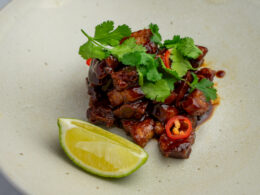A classic UK/American Chinese take out dish, Crispy Sweet and Sour pork is a thing of beauty, sweet, salty and tangy – it’s popular for a reason. Thin marinated pieces of pork are tossed in a batter and deep fried rapidly, drained and tossed with stir-fried vegetables and a sweet and sour sauce.
Normally it’s a dish that can be put together quickly in professional Chinese take-out kitchens with their high powered burners and a multitude of woks. But you might be surprised to know that it’s actually incredibly easy to put together at home. You also might be worried about deep-fat frying at home but I’ve put together a guide to ensure that it’s a relatively odour and mess free process.

How to make crispy sweet and sour pork
Making Crispy Sweet and Sour pork is actually surprisingly quick and the prep process before cooking can be broken down into 4 steps:
- Tenderising and marinating the pork
- Making the batter
- Preparing your vegetables
- Making the sauce
This recipe breaks down the steps, answers commonly asked questions and gives you alternatives to ingredients.
What pork to choose for sweet and sour pork
Choosing the right cut for sweet and sour pork is important to ensure that you have good end results. Since we’re flash frying thin slices of tenderised meat we want to choose a cut that is full of flavour but isn’t too fatty.
Here’s a list of possible cuts to choose from:
- Pork Shoulder/Butt: The choice of most Chinese restaurants around the world with its amazing fat marbling and deep pork flavour. Pork butt is usually a tougher cut which means you need to cook it for a long time to break down the tough collagen and turn it into something juicy and tender. However for this recipe, by slicing the meat finely and tenderising it, you’ll end up with a super soft, melt-in-the-mouth result.
- Pork Collar: (or pork steak in some countries) A great option as pork collar is extremely versatile – it can be grilled quickly or even slow roasted (for Char Siu pork, for example). Extremely popular here in France, it’s got plenty of fat which adds a lot of flavour.
- Pork Fillet: (or pork fillet mignon) similar to the a beef fillet mignon, the pork fillet is the most tender cut of pork. As with the beef cut, it’s relatively low on flavour as it’s extremely lean. I’ve used this cut more often than not for this recipe as I frequently have left over un-cooked fillet from a previous dish. Many recipes will tell you not to use this cut as you will end up with dry, chewy meat. However I’ve found that with tenderising and marinating the meat, even after cooking it past 60c internal temperature, I’ve had great results.
- Pork loin: Usually available as a large Pork Loin Roast, pork loin is a great cut for many stir-fry recipes. Like pork fillet, it is rather lean so it’s important to marinate and tenderise well before cooking. An instant read thermometer also helps to ensure you don’t overcook the meat.
Which cuts not to use:
- Pork belly: A fantastic cut to prepare and eat for many dishes but it’s just not a cut that suitable to deep-fry in batter.
- Pork shank/leg: A bone-in cut which is heavy on fat, it’s really a time consuming cut to prepare for this kind of dish – avoid.
- Ribs: Bone-in spare ribs should be avoided unless they’ve been deboned.
Washing & tenderising the meat
Washing pork
One of the little known ways to tenderise beef or pork is to wash the meat before adding to a marinade.
Note: This is not for sanitary purposes like some people feel that they need to wash their chicken! (Which should be avoided)
Why should you wash your meat for a stir fry? Two reasons:
- Washing the meat removes blood and excess moisture allowing for a cleaner taste and allowing for the marinade to penetrate further into the meat
- When washing and wringing out the meat, the physical act of squeezing and massaging the meat acts like mechanical tenderisation – just like with a meat mallet! By doing this, you’re helping to break down muscle fibres which result in a much more tender piece of meat. Try it – you’ll see the difference!
Tenderising pork
A long with washing the pork, the marinade process helps tenderise the pork even further.
We use baking soda in the marinade to achieve this. How does this work? Baking soda is alkaline which, when added to meat, alkalises the surface of the meat therefore mitigating protein tightening and bonding (i.e when protein strands shrink when cooked). The result is a much tender piece of meat.
Sweet and Sour Sauce
The sweet and source sauce in this recipe is based on a classical US/UK-Chinese take-out sauce. It’s tangy yet not overly sweet! Here’s a breakdown of what’s in the sauce:
- Ketchup: This brings a ready-made sweet and sour base with a bright red colour for appearance and a thickness from the tomato purée. This can be left out if you don’t have it on hand but you won’t get the red colour although it could be replaced with a teaspoon of tomato paste.
- Rice vinegar: This brings acid (the tanginess) for the sauce.
- Sugar: This is to add sweetness to the sauce.
- Pineapple juice: for an extra fruity sweet and sour note – it really makes a nice addition!
Optional ingredients:
- Worcestershire sauce: Feel free to add if you’ve got some laying around in your pantry – this will add a bit of umami.
- MSG: Add if you want an umami boost for the real take-out experience.
- Red food colouring: Add a tiny amount if you want to get a real take-out-like appearance.
How to batter sweet and sour pork
The batter for Sweet and Sour pork is simply: general purpose/plain flour, potato starch and water.
Simply add equal quantities of flour and potato starch, add water and mix until you have a thick batter.
Frying the pork
Before frying, it’s important to ensure that all pork pieces of even coated in the batter. Once the fryer/pot/wok of oil has reached 180c, we place the pieces into the fryer and fry rapidly – around 2 minutes. Once the pork has hit 55c internally you can remove.
Double frying is not needed for this recipe but you can do so if you want – after glazing in the sauce, I generally find any crispness to be lost (I’ve found the same in restaurants as well).
What you need to make Sweet and Sour Crispy Pork
Serves 2
For the pork and marinade:
- 200g of pork shoulder/butt or collar
- 1 tbsp spoon of light sauce soy sauce
- 1 tsp of dark soy sauce
- 1 tsp spoon of sugar
- 1 tsp spoon of salt
- 1 clove of garlic microplaned or pressed
- 1 tsp of cornflour
- 1 tsp of Chinese cooking wine
For the batter
- 100g of potato starch
- 100g of corn flour
- Water, as required
For the sauce
- 3 tbsp of Ketchup
- 50g (2 tbsp) of sugar (any kind)
- 80ml of rice vinegar
- 1 tbsp of light soy sauce
- 1/5 tsp of red food colouring (optional)
Cornstarch & water for a slurry
For the stir fry
- 1/2 a red bell pepper
- 1/2 a green bell pepper
- 1/2 a red onion
- 1/2 a carrot
- 2 slices of canned pineapple
Steps
- Start b y cutting your pork into thin small slices – approx 5 cm long and 1.5cm wide. Place the pork into a bowl and fill with cold water, really get in there with your hands and massage the meat for 20 seconds. The water will be browny/red from the blood and excess liquid that is reduced. Drain the bowl and wring the meat to get rid of any liquid. Place into a separate dry, clean bowl.
- Place all the marinade ingredients in with the pork and use your hands to mix and combine the mixture so the cornstarch has dissolved and every piece is coated. Reserve in the fridge for at least 30 mins to marinade.
- Prepare the vegetables for stir-frying. Cut all the vegetables in equal sized pieces 2.5cm cubes of equal thickness.
- Prepare the sauce, combine all ingredients together and reserve.
- Make the batter, combine all ingredients and whisk until you have a very thick batter. It should be much thicker than heavy/double cream.
- Heat the oil in the fryer to 180c.
- Place marinaded meat into the batter and ensure all pieces are coated in batter. Fry for 1-2 minutes or until the internal temperature is at least 55c with an instant read thermometer. Remove from the fryer and reserve.
- Quickly heat up a table spoon of neutral oil in a wok or a large frying pan and sear until you have some blistering on the vegetables, toss regularly. After 1 minute add the sauce followed by a bit of the cornstarch slurry – add more if needed to ensure the sauce is a thick glaze.
- Add the fried pork pieces and toss to ensure all pieces are covered by the sauce. Ensure that they are not kept in the pan for longer than 15 seconds.
- Serve on steamed white rice.
Is Sweet and Sour pork breaded?
No, traditionally the pork is not breaded but battered with a simply starch based batter.
Can you cook it in the air fryer?
Yes however it really won’t be as good compared to a fried version.












